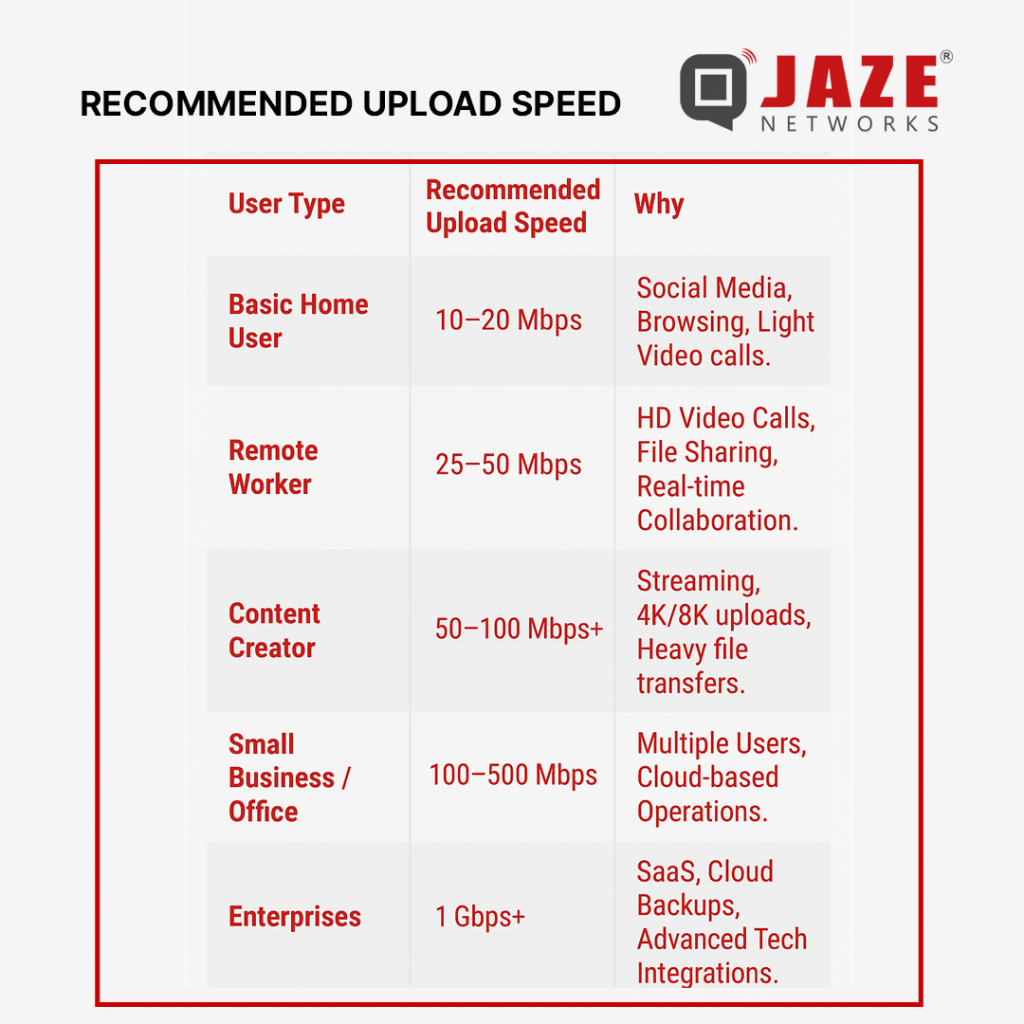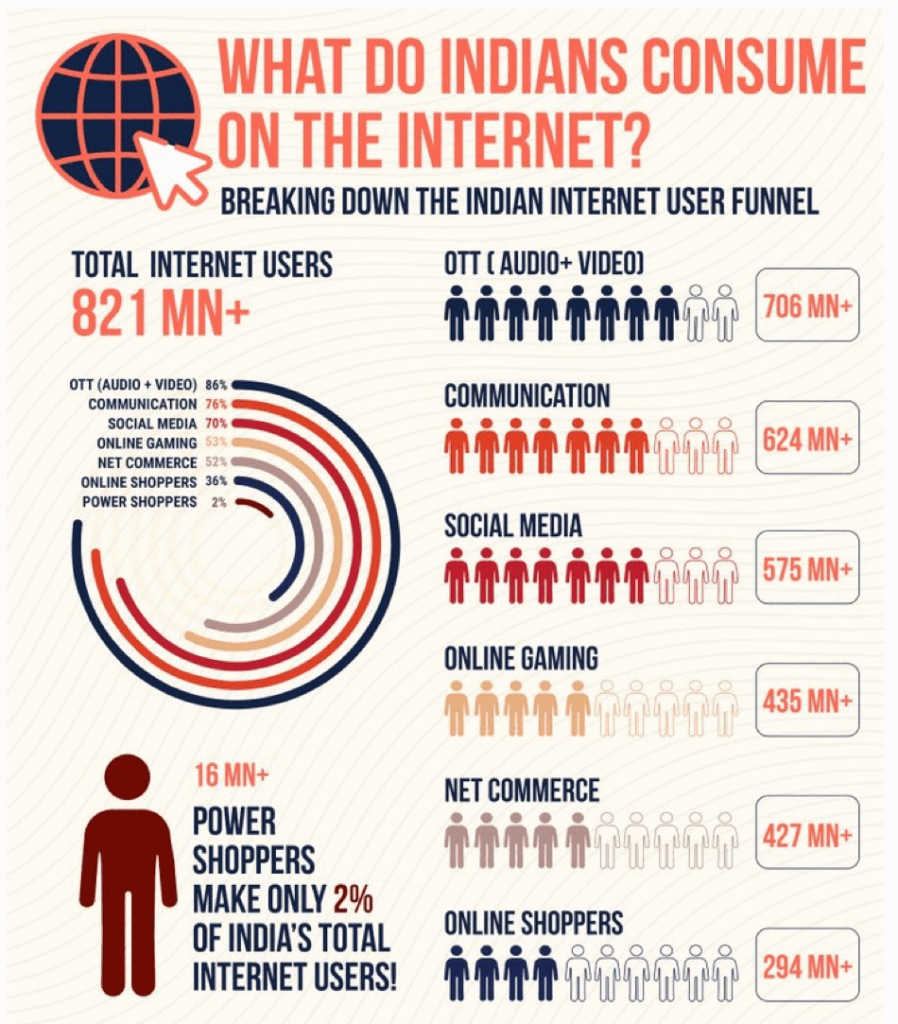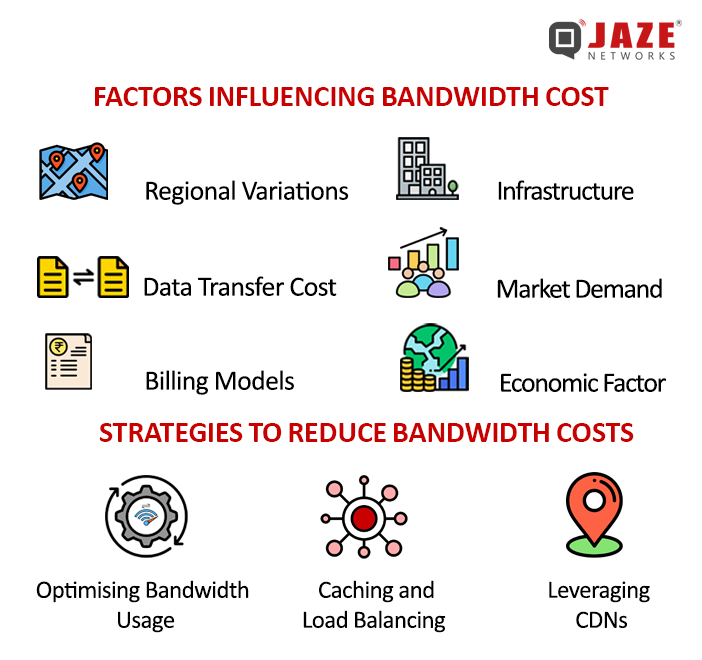




When we talk about internet speed, most people instantly think about how fast they can download movies, stream videos, or browse social media. But in today’s world, it’s not just about downloading anymore — upload speed is equally important.
As we step into 2025–2026, when remote work, cloud storage, video creation, and smart devices dominate daily life, upload speed can make or break your digital experience.
Let’s understand why it matters — and how it affects almost everything you do online.
What Exactly Is Upload Speed?
Upload speed refers to how quickly you can send data from your device to the internet.
It’s measured in megabits per second (Mbps), just like download speed.
Every time you:
—you’re using your upload bandwidth.
If your upload speed is low, even a strong download connection can feel sluggish or unstable during these tasks.
1. The Era of Remote Work & Online Collaboration
Work-from-home and hybrid models are here to stay. Every video meeting, shared file, or cloud document relies on your upload connection.
A slow upload speed means blurry video calls, lagging audio, and constant “reconnecting…” messages — not ideal when you’re presenting to clients or attending classes online.
2. Social Media & Content Creation Boom
From influencers to small business owners, everyone is uploading photos, reels, and videos daily.
With 4K and 8K becoming standard, files are huge. High upload speed ensures your videos go live faster — and without frustrating delays.
3. Cloud Storage & Backup
We’re moving away from storing everything on devices. Automatic backups to Google Photos, iCloud, and OneDrive constantly use upload bandwidth.
If upload speeds are low, backups slow down, sync fails, and your data may remain outdated.
4. Smart Homes & IoT Devices
Cameras, sensors, and voice assistants send continuous data to cloud servers.
When upload bandwidth is insufficient, you’ll see camera feed delays, failed device syncs, or unreliable smart automation.
5. Gaming & Live Streaming
Gamers know the pain of lag.Online gaming and live streaming both rely on strong upstream connections — every action, every frame, every voice chat goes out through your upload channel.
Higher upload speeds mean smoother gameplay and crystal-clear streams.
| Online Activity | Recommended Upload Speed |
| Video calls (Zoom, Meet) | 3–5 Mbps |
| Cloud backups | 10–20 Mbps |
| Online gaming | 5–10 Mbps |
| 4K live streaming | 20–25 Mbps |
| Uploading large media files | 25 Mbps and above |
If multiple devices or users share the same connection, you’ll need even higher speeds for a seamless experience.

India’s internet usage pattern is shifting fast. Earlier, most users were consumers of content — watching, downloading, or streaming.
But now, millions are creators — students uploading projects, professionals hosting webinars, and entrepreneurs managing online stores.
Unfortunately, many broadband plans in India still prioritize download speeds and offer much lower uploads (often just 10–20% of download rates).
That imbalance is slowly changing, as fiber networks and symmetrical connections become mainstream.
Traditional broadband (like copper or DSL) can’t handle equal upload and download speeds.
But fiber-to-the-home (FTTH) connections deliver symmetrical speeds — meaning if you get 200 Mbps download, you also get 200 Mbps upload.
This makes a huge difference for:
Fiber technology is the backbone of India’s digital growth — and it’s finally bridging the upload gap.
As India embraces a creator-driven digital economy, upload speed is no longer secondary — it’s essential.
Whether you’re working from home, managing an online business, or sharing your creativity with the world, faster upload speeds ensure smoother, smarter, and more reliable connectivity.
Jaze ISP Manager helps ISPs by optimising bandwidth delivery and provide a seamless experience to subscribers. This ensures stable upload speeds for users, reduces congestion during peak hours, and improves performance for video calls, cloud backups, and live streaming. In short, it gives ISPs the tools to maintain reliable upstream performance for their customers. Click here to know more
India’s digital transformation has been one of the most significant global stories of the past decade. With over 820 million internet users, the country has emerged as a digital-native economy, despite having a GDP per capita of just over $2,700. While many countries transitioned gradually from desktops to smartphones, India skipped a few steps—embracing mobile-first access from the start.
This shift isn’t just about personal connectivity—it’s reshaping how industries operate, especially the business events sector. To stay relevant and future-ready, industry players must understand the implications of India’s digital adoption and build strategies around it.
India’s digital growth is powered by affordable smartphones and low-cost data plans, making internet access more democratic and widespread.
This has created an environment where digital content, platforms, and tools are more relevant than traditional, hardware-intensive solutions.

The nature of India’s digital access changes how audiences engage with content and events. Traditional formats no longer suffice. Instead, digital-first strategies must become central to event planning, marketing, and execution.
Here are three key ways the business events industry can evolve:
Event organisers must think beyond the physical venue. With millions of people accessing content via mobile phones, the potential reach is enormous—if content is tailored and distributed effectively.
Modern venues must support more than Wi-Fi. They need to enable seamless content creation, hybrid streaming, and sustainable practices powered by digital infrastructure.
Vendors—whether tech providers, production partners, or logistics firms—play a crucial role in helping organisers and venues bridge the digital gap.
To build an inclusive, sustainable events industry in India, stakeholders must experiment with digital technologies at every level—from promotion and operations to post-event analysis.
India’s digital-first population presents an incredible opportunity—but only for those prepared to adapt. Organisers, venues, and vendors must rethink their roles and responsibilities in a mobile-led world. By embracing digital tools, supporting inclusive infrastructure, and prioritizing sustainability, the business events industry can truly evolve to serve India’s next billion internet users.
As digital connectivity becomes central to every industry, Internet Service Providers must modernize how they operate.
Jaze ISP Manager helps ISPs manage their broadband business with ease—offering automated customer support, real-time network monitoring, intelligent fault detection, and direct revenue sharing between franchises. It’s a complete solution designed to improve reliability, simplify operations, and support scale, especially in mobile-first markets like India.
Click here to know more.
In an era where streaming, video conferencing, and real-time gaming dominate digital activity, most users still equate better internet with higher bandwidth. But the real indicators of network quality lie deeper—in factors like latency, jitter, and bufferbloat. Understanding these metrics is essential to achieving consistent, high-quality connectivity.
While bandwidth defines the maximum data transfer capacity, it doesn’t ensure consistent delivery. Think of bandwidth as the width of a pipe, not the speed or smoothness of water flow. High bandwidth with unmanaged latency and jitter can still lead to poor Quality of Experience (QoE).
Latency measures the round-trip time data takes to travel between a device and a server. High latency creates noticeable delays, especially during:
Solution:
Jitter represents fluctuations in packet arrival times, which leads to data arriving out of sync. This is particularly disruptive for time-sensitive applications like:
Solution:
Bufferbloat occurs when network devices over-buffer packets, introducing delay and congestion even when bandwidth is not fully utilized.
Symptoms include:
Solution:
While a fast connection helps with large file downloads or 4K streaming, real-time communication depends more on network consistency than on raw speed.
Best Practices:
For ISPs and enterprise network managers, focusing solely on delivering higher speeds is no longer sufficient. Real competitive advantage lies in offering:
Maximizing internet performance isn’t about bandwidth alone. To truly optimize the end-user experience, network administrators and users alike must address the hidden factors—latency, jitter, and bufferbloat—that directly influence application responsiveness and reliability.
Investing in smarter infrastructure, performance-aware configurations, and end-to-end visibility will ultimately provide a smoother, faster, and more predictable network experience for all users.
To improve Quality of Experience (QoE) beyond just bandwidth, Jaze ISP Manager equips ISPs with meaningful insights into subscriber usage.
Jaze ISP manager in integration with BNG routers supporting FQ-CODEL based AQM helps to optimize the quality of experience effectively managing latency, jitter, and bufferbloat.
Click here to know more.
As digital consumption continues to rise, bandwidth management has become crucial for businesses, especially those reliant on cloud services. Bandwidth, the amount of data transferred over a network in a given time, plays a significant role in determining operational costs. Without effective control, bandwidth expenses can escalate quickly, particularly in industries dependent on high volumes of data transfer.
This article will explore the key factors influencing bandwidth costs and provide strategies to reduce them.

Factors Influencing Bandwidth Costs
Understanding what drives bandwidth expenses helps businesses manage their usage efficiently and avoid unnecessary costs. Here are some critical factors that affect bandwidth pricing:
1. Regional Variations
Bandwidth costs can differ based on geographic regions. Areas with advanced infrastructure and competitive markets tend to have lower costs. Conversely, regions with underdeveloped infrastructure or monopolistic market conditions face higher prices.
2. Data Transfer Costs
Many providers charge based on the volume of data transferred, typically measured in gigabytes (GB). Outbound data (sent from your network) often incurs higher costs compared to inbound data (received by your network). Providers like Google Cloud or AWS follow this model, where inbound transfers may be free, but outbound data can significantly drive up costs.
3. Billing Models
Different billing models can influence how much you pay for bandwidth:
Flat-Rate Pricing: A fixed monthly fee ensures cost predictability but may result in paying for unused bandwidth.
Pay-As-You-Go: Costs are based on actual usage, which is flexible but can lead to high expenses during peak periods.
Tiered Pricing: A tier-based approach offers a balance of predictability and flexibility, accommodating business growth.
4. Infrastructure and Peering
Regions with well-developed peering exchanges enable more efficient data transfer between networks. This reduces bandwidth costs by lowering the need for long-distance data transmission.
5. Economic Factors
Bandwidth costs are also affected by external factors such as power, cooling, and real estate costs. Data centers located in regions with high electricity prices or expensive real estate tend to pass those costs onto their customers.
6. Market Demand
In areas of high internet demand, especially during peak times, service providers may increase prices. High market demand for bandwidth can drive up prices, particularly in growing internet markets.
Strategies to Reduce Bandwidth Costs
To manage bandwidth expenses effectively, businesses must adopt strategies that optimize their data usage. Here are some key ways to reduce bandwidth costs:
1. Optimizing Bandwidth Usage
Managing bandwidth usage is essential for minimizing unnecessary data transfer:
Data Management: Prioritize essential data transfers and schedule non-essential ones during off-peak hours to reduce congestion.
Compression Techniques: Compressing large files such as images or videos before transferring them can drastically reduce the amount of data sent, lowering bandwidth costs.
Monitor Usage: Regularly analyzing bandwidth usage can reveal inefficiencies or heavy usage patterns, guiding businesses to implement specific cost-saving measures.
2. Caching and Load Balancing
Caching allows frequently accessed data to be stored locally, reducing repeated data transfers. For instance, implementing caching for images or videos can drastically cut data transfer to and from the server. Load balancing helps distribute network traffic across multiple servers, reducing the strain on any single server and preventing bandwidth overuse.
3. Using Content Delivery Networks (CDNs)
A CDN consists of a network of servers distributed across multiple locations, which cache and deliver content closer to users. CDNs reduce the load on the original server by handling static content like images, CSS files, and videos. This minimizes the need for repeated data transfer from the origin server, leading to significant bandwidth savings. CDNs are highly effective, often managing 60-80% of a website’s bandwidth, allowing the original server to focus on more critical functions.
Monitoring bandwidth usage regularly will also help businesses avoid unexpected costs and ensure more efficient network management. Implementing these methods can provide both immediate savings and long-term benefits, making them crucial for growing companies in today’s digital landscape.
Jaze ISP Manager provides comprehensive tools for monitoring bandwidth usage, offering real-time insights and detailed usage reports. This solution enables Internet Service Providers (ISPs) to manage end-to-end operations, including subscriber lifecycle management, billing, and policy enforcement. With features like automated provisioning, flexible billing options, and integration with various network equipment, Jaze ISP Manager helps businesses optimize resource allocation and ensure efficient network performance. Click here to learn more